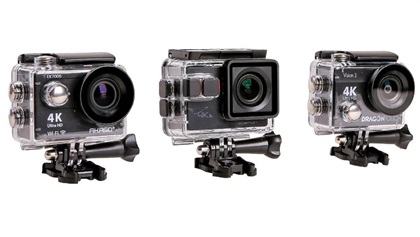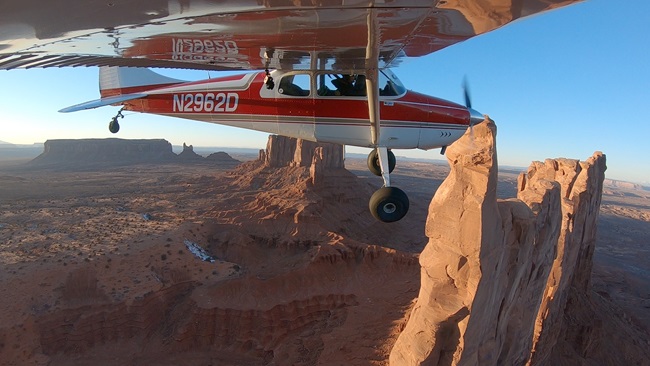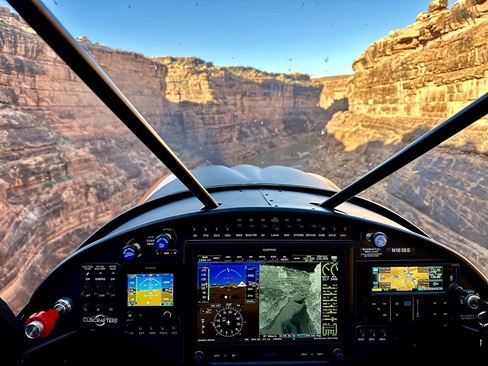Ownership: Budget battle
Are inexpensive action cams worth their low prices?

They’ve made YouTube stars of pilots, and helped many students over training hurdles (see “Technique: Perception Isn’t Reality,” August 2020 AOPA Pilot). But at $400 or more, they are a pricey accessory for hobbyists.
If you’ve searched for these cameras or their accessories on Amazon like we have, a curious thing catches your eye—cameras that look and feel similar to the GoPro Hero or Garmin Virb that cost hundreds of dollars less. We wondered: Is it worth paying so much for a camera when what appear to be perfectly reasonable substitutes are all over Amazon? So, we chose three and handed them off to AOPA Senior Photographer Chris Rose to see what he thought.
He ran the Apeman A87, AKASO EK7000, and Dragon Touch 4K through multiple evaluations, including general quality and usability, battery life, photo quality, video quality, and value. These three were chosen because they represent three price points; each had high user ratings; and, honestly, we had to cut it off somewhere. Cheap action cameras are plentiful on Amazon, and narrowing them down can be difficult.
Value
We started this process with price in mind, and here each scores highly. We paid $39.99 for the Dragon Touch, $49.99 for the AKASO, and $79.99 for the Apeman. With action cams, the actual camera is only part of the buy. You must also purchase a backpack full of accessories. We were extremely impressed with each camera’s offerings. In fact, Rose, an avowed gearhead, said he would consider buying the Apeman solely for the case it comes in. The semi-hardshell case with foam slots for the camera and accessories makes the package a great value.
While the AKASO and Dragon Touch didn’t come with premium cases, they did come with a dizzying array of accessories and mounts. Waterproof cases, sticky mounts, and clamp mounts are all included. Now the bad news: Although some claim to be compatible with GoPro mounts, Rose didn’t find that to be the case—at least, not without modifications. So, don’t buy the camera as a way to get cheap GoPro mounts.
General quality and usability
Rose commented favorably on the manufacturing, packaging, and finish of each camera. If you’re worried how other pilots will look at you if you pull out a cheap camera, don’t worry. It’s hard to tell many of these apart, with the exception of logos. The AKASO comes away with the best overall feel of quality. The Apeman, while having an overall good build quality, has a difficult battery door mechanism that knocked it down a bit.
All three cameras have screens to use as viewfinders and to navigate the menu, but only the Apeman features a touchscreen. Rose found each of the menus easy to operate and intuitive. Don’t expect mobile app control, but each comes with a Wi-Fi remote.

Battery life
One thing you quickly learn when testing battery life is that specs are somewhat useless. Each camera features a 1,050 mAh battery, but the tests showed vastly different run times. For this test Rose fully charged each battery and let the camera run until the battery died. And with battery life you get what you pay for. The Dragon Touch ran for 68 minutes, the AKASO for 92 minutes, and the Apeman for a respectable 118 minutes.
In addition to battery life we also looked at how many batteries came with the camera, and how easy (or not) they were to recharge. And we were impressed. All three cameras come with two batteries, effectively doubling those run times. The AKASO and Dragon Touch also come with drop-in battery chargers that enable you to easily charge both batteries at the same time. Strangely, the Apeman doesn’t, which means the only way to charge the battery is to plug in the camera, and then switch out the battery that needs to be charged.
Photo quality
In terms of photo quality, we should say up front that Rose is a tough critic. He has exceptionally high standards when it comes to taking and editing photos. Indeed, none of the cameras lived up to Rose’s expectations.
Starting with the worst of the bunch, Rose called the Dragon Touch’s photo quality “unacceptably poor.” The photos had a lot of noise, the resolution was bad, and the number of artifacts high. (An artifact is an unwanted aspect of a photo that doesn’t appear in the original scene.) A picture of the sky, for example, resulted in bands of distinct blue bars with no natural gradation. The manufacturer claims 16 megapixels, but that seems irrelevant.
Only slightly better in performance, AKASO claims a resolution of 12 megapixels. Rose found the photos to be full of artifacts with clipped highlights and the same banded tones. He was, however, pleased with the saturation and found little to no vignetting.
The Apeman claims 16-megapixel photos, which Rose found to be just OK. Most of the photo aspects he described as “acceptable,” including the low-light performance, resolution, tonality, and color. He rated the lack of distortion “excellent” and backlit photos had little to no lens flare.
Video quality
Here, again, Rose is a stickler for quality. And most of us have come to expect great quality from name-brand video cameras such as the GoPro Hero or Garmin Virb. The quick verdict on these budget cameras is that they can’t keep up with the top name-brand models in terms of video quality. In particular, video stabilization, that nifty software trick that dampens the constant wobble airplanes generate on action cams, is poor on all three models. But it’s not all bad news.
Interestingly, price didn’t necessarily match quality. The Dragon Touch, the cheapest camera, performed the best in terms of video stabilization. Rose also rated the Dragon Touch’s video resolution the best of the three. But in terms of color, contrast, and overall video quality, it was the worst. The AKASO and the Apeman both performed at an acceptable level. He liked the color on both, but said all three were noisy, and not up to current standards. “Think GoPro generation two,” he said.
 In terms of specs, each purports to shoot in 4K, although Rose found the claims dubious. The Apeman says it even shoots it at 60 frames per second, a pretty incredible claim from such a cheap camera. But, again, specs are only part of the story, and in this case, it was the best part.
In terms of specs, each purports to shoot in 4K, although Rose found the claims dubious. The Apeman says it even shoots it at 60 frames per second, a pretty incredible claim from such a cheap camera. But, again, specs are only part of the story, and in this case, it was the best part.
Final verdict
Don’t buy any of these as a sneaky way to stick it to GoPro or Garmin prices. You’ll be disappointed. But do buy one if you’ve never had an action cam and want to see what they’re all about. Or maybe you’re a student pilot or instructor who needs an instructional aid. Or you’re a photographer for the world’s best aviation magazine and your boss doesn’t like the idea of risking a $400 camera being stuck to the float of a Beaver or Caravan, but maybe he’ll get behind risking $50.
Email [email protected]



